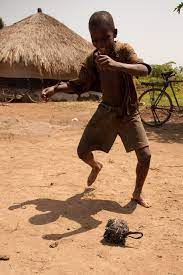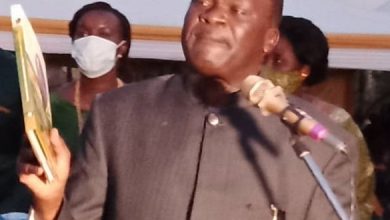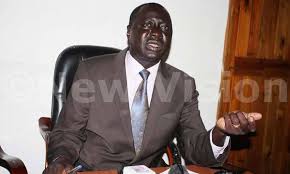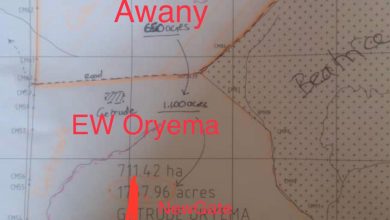
Uncategorized
WHY MUST THE ACHOLI PEOPLE ENDURE THIS?
Is this then a continuation of the original anti-Acholi agenda?
BY DR (now PROF) MORRIS OGENGA-LATIGO WOD AMIDA.
Article published in the Daily Monitor and The People Newspapers on 15th & 17th May 1995.
When news of Kony’s massacre of students and local people in Atiak broke late last month, colleagues in the faculty heavily confronted me.
Why do you kill your own people? What is wrong with you Acholis? Why don’t you end this rebellion? They asked. One Adhola cousin was so enraged he could have fought me.
I was bewildered but not angry with them. I got scared though, realizing the extent to which the many years of negative propaganda against us has so severely distorted the country’s perception of our problem. Many an Acholi faced the same dilemma.
Then on Wednesday that week, the Monitor newspaper published an editorial and article on the issue. For the first, we thought, some people have looked at the Kony problem critically and are prepared to present them objectively and in proper perspective.
Reading official speeches made during the memorial service held for victims of the massacre at Pece War Memorial Stadium, Gulu, as reported in the New Vision of April 29, however, one could not help being very angry. This never-ending anti-Acholi propaganda has gone on too long.
Without fear of contradiction, it can be said that there has been a long-standing difference between the Acholi and NRM leadership, dating back to the Amin era. The difference first manifested itself strongly during the UNLF period.
As the dominant group in the UNLA, Acholi soldiers were instrumental in thwarting Yoweri Museveni’s buildup of loyal forces in the post-Amin army. For this, they were singled out for punishment and destruction. Two incidences illustrate the point.
In 1980, following accusations in the NCC that a private army was being trained in the North, Yoweri Museveni as Defence Minister toured Kitgum. At a rally he addressed under a fig tree in Kalongo, he singled out the Acholi for thinking that they were militarily invincible, promising that they would one day be dealt with with telling consequences.
Later in the same year, when travelling to Gulu, we found a vehicle carrying Andrew Adimola, then a government minister, had knocked a Muhima herdsman at Kigumba. One of the Bahima army officers responded to the accident on finding Adimola stabbed him swearing that “we will one day deal with you Acholi”.
The anti-Acholi campaign escalated during the Luwero insurgency. Thus, although the war was between UNLA as a national army and NRA, the killers in Luwero were always the “Bacholi”.
Even when the NRA/M took power, it was only Acholi elders who were brought to Luwero to “see the skeletons of the Baganda killed by your sons”.
What justification was there for singling out the Acholi?
We offer no excuses for the Luwero tragedy. Any killing of citizens by security personnel employed to protect them, no matter the magnitude, is inexcusable and unacceptable. But, surely, an objective and non-sentimental history of that war is yet to be told.
It is nevertheless a fact that no single Acholi UNLA commander has been linked to the atrocities in Luwero. Historically, the Acholi as a people never run away from a good fight, kill senselessly or fight treacherously, and they are not vindictive.
It is also a fact that the NRA got the bloodiest nose in Luwero in the hands of Kennedy Kilama and Eric Odwar, two outstanding Acholi UNLA commanders. If they were atrocious, why did Salim Saleh and other top NRA’s regret and mourn their deaths in the Lakwena insurrection? Why was Kilama buried formally by the NRA ?
Contrary to what has been propagated to the country and the whole world, and many have come to believe, the insurrection in the North did not begin because Acholi wanted to overthrow the NRM government. We have never desired to take over any government. Even against Obote, the Acholi were driven to the coup because their lives were endangered.
When the NRA reached our land in 1986, preaching peace, reconciliation and unity, thousands of former UNLA soldiers came out of hiding. Over 20,000 guns were surrendered voluntarily, and everyone was hopeful that peace was at last coming.
That was not to be, the agenda against the Acholi had not been fulfilled yet. Thousands of well-trained Acholi who left the army and were within or outside the country still constituted a military threat. True to the earlier promise, this military might have had to be destroyed.
The NRA/M knew best how to trigger in Acholi land a war of attrition guaranteed to destroy the fabric of our society. Under Idi Amin, the Acholi were traumatized by the slaughter of thousands of their best and were extremely liable to react to any violence against them no matter the risk.
When units of the NRA began killing people and arresting and torturing ex-soldiers in 1986, therefore, our people rose up vowing that this time, “we will not be slaughtered like pigs”. Thus started the insurrection in Acholi.
The war was a fight for survival and an attempt to force government to recognize our rights as Ugandans and to safeguard and guarantee the security of our society. Nothing more.
It is of course true that political elements and some individuals tried to use the insurrection for their own ends. The highly oppressed Acholi in urban canters also looked to it as a source of hope and psychological therapy. This was nothing strange and was expected.
To government, however, the war in Acholi, besides its intended goal, was a critical propaganda tool. The “backwardness”, “primitivity” etc. of “these people” became the talk of the day. The NRM used the war to entrench its support through fear. It also did all it could to establish a permanent rejection of an Acholi or Northern leadership of Uganda, and to build an indelible international image of civility, while knowing all along what was going on.
Acholi politicians who articulated our sentiments and fought for our rights became targets of the NRM. Because they talked, the Okullus were accused of supporting the rebellion, removed from government and branded as those “unrepentant of the sins they committed against our people”. False accusations, arrests and torture were used to intimidate others.
With the defeat of Lakwena, the insurrection in Acholi effectively ended. The population immediately embraced peace moves initiated by church leaders, and whole-heartedly joined with government to re-establish peace.
Unfortunately, hostility against the Acholi did not end with the rebellion.
Come the CA election, the Acholi, who suffered incomparably under the NRM rule, voted for people they believed would guarantee their freedom and rights in the new constitution. The NRM was highly offended by the results as not a single candidate backed by it was elected.
Our delegates immediately joined hands with other Acholi to establish peace in the region as a safeguard of the people’s rights and freedom and to remove the insecurity excuse peddled by government to block development in the region. This effort led to the formation of Acholi Pacification Committee, and the mobilization of local militia to fight Kony and build security in our region.
Yet, this positive development was undermined and destroyed. Intense propaganda was mounted against Tiberio Okeny and Leander Komakech, the two politically unshakable delegates. The immature and highly ambitious of our delegates were enticed with power and personal gains to betray their mission in the CA and were then used to fight those that the NRM did not want.
On the surface, this was an effort by the NRM to build support for its position in the CA. However, the purpose and effect were clearly to undermine the unity of our people. With its majority in the CA, the NRM does not need Acholi votes.
Is this then a continuation of the original anti-Acholi agenda?
To the Acholi, the NRM has never really wanted to end insecurity in our land and continues to use the Kony rebellion for political gains. We recall, for example, the scuttling of the peace talks between Kony and local leaders by the President’s seven-day ultimatum, and question why government threatened a military solution that has not worked for years.
We wonder why government deliberately refused to destroy the rebels who were then surrounded, as reported by Amama Mbabazi, allowing Kony instead to escape to Sudan. What importance was there in how NRA/M fought Kony when they used to mow down Lakwena rebels armed only with stones, and to plant land mines and kill civilians in Luwero?
In February in Padibe, Kitgum District, rebel infiltration was reported to the local NRM unit. To the shock of everybody, the army did not respond and even blocked the militia from confronting the rebels who proceeded to freely kill people and loot property. Why did this happen?
In the recent attacks in Acholi, it was primarily Acholi militia armed with a few and sometimes defective guns who faced and died in the hands of the thugs. Why, we ask, has government decided to decentralize responsibility for this insecurity to us while it swiftly moves against the Itongwas elsewhere?
Although the President was reassuring in Gulu, did government response to the Atiak massacre really reflect any concern for what happened? No! The NRM was pre-occupied with propaganda and political gain.
No statement of concern or regret was issued by government or the NRM. The country was only put to shame when, in the silence, only the voices of lamenting Acholis could he heard.
No genuine government sympathy was even heard during prayers the Acholi organized for their dead.
Amazingly, the Acholi heard their own daughter, Minister Betty Bigombe, attack the Monitor Newspaper for expressing regret for the wanton killing and for urging government to commit itself to ending the suffering in Acholi.
Vice President Specioza Kazibwe, in her characteristic anti-northern rhetoric, unashamedly blamed the whole issue on our leadership.
Intent on political gain, she linked the solution of the prolem to our putting the right leaders in place. Which leaders does NRM want in Acholi? Worst still, she accused the Acholi of being treacherous to the NRM.
From the coming to power of the NRM, haven’t the Acholi provided the largest number of NRM leaders at the district level (DA/CGR), even more than the Banyankole? When ethnic NRMs failed to end rebellion in Teso, didn’t the government deploy Acholi civil and military leaders who ended it?
Does the country know that right now the CGRs of Gulu, Kitgum, Apac, Soroti, Hoima, Kasese and Kabale are Acholi, and that there are at least six other Acholi ACGRs?
Do Ugandans know that the Directors of Military Intelligence and Transport in the NRA are Acholi, and that very many Acholi senior army, police and prisons officers and men continue to faithfully serve this nation? Which of them has betrayed the NRM and become an Itongwa?
In the ten years of NRM rule, has the President and other rulers even once acknowledged our contribution to the NRM and this country?
What have our people and region earned with this loyalty and dedication, is it the death, poverty and social decline now pervading our region?
When NRM undermines our forthright leaders, and corrupts and uses promising ones to destroy the aspirations of our people, who is being treacherous? Why must Acholi endure all this?
For us, the struggle against subjugation is fundamental and death and any other price that we have to pay is never too high.
Let it be made very clear. We mean well to all Ugandans and will never undermine the wellbeing of the country. Government and those who begrudge us our honesty, forthrightness, independence and courage must recognize this and allow peace to prevail in our land.
About the Author.
Dr M.W. Ogenga-Latigo is a Senior Lecturer and leading Researcher and Graduate Trainer at Makerere University.




